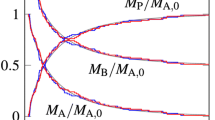Abstract
Traditionally the kinetics of a chemical reaction has been studied as a set of coupled ordinary differential equations. The law of mass action, a tried and tested principle for reactions involving macroscopic quantities of reactants, gives rise to deterministic equations in which the variables are species concentrations. In recent years, though, as smaller and smaller systems – such as an individual biological cell, say – can be studied quantitatively, the importance of molecular discreteness in chemical reactions has increasingly been realized. This is particularly true when the system is far from the ‘thermodynamic limit’ when the numbers of all reacting molecular species involved are several orders of magnitude smaller than Avogadro’s number. In such situations, each reaction has to be treated as a probabilistic ‘event’ that occurs by chance when the appropriate reactants collide. Explicitly accounting for such processes has led to the development of sophisticated statistical methods for simulation of chemical reactions, particularly those occurring at the cellular and sub-cellular level. In this article, we describe this approach, the so-called stochastic simulation algorithm, and discuss applications to study the dynamics of model regulatory networks.
Similar content being viewed by others
Suggested Reading
E L King, How Chemical Reactions Occur. An Introduction to Chemical Kinetics and Reaction Mechanisms, Benjamin, New York, 1963.
K J Laidler, Chemical Kinetics, (3/e), Pearson, 2003.
H A Kramers, Brownian Motion in a Field of Force and the Diffusion Model of Chemical Reactions, Physica, Vol.7, 284, 1940.
M Delbrück, Statistical Fluctuations in Autocatalytic Kinetics, J. Chem. Phys., Vol.8, pp.120–124, 1940.
D A McQuarrie, Stochastic Approach to Chemical Kinetics, J. Appl. Probab., Vol.4, p.413, 1967.
D T Gillespie, Exact Stochastic Simulation of Coupled Chemical Reactions, J. Phys. Chem., Vol.81, pp.2340–2361, 1977.
Y Cao and D C Samuels, Discrete Stochastic Simulation Methods for Chemically Reacting Systems, Methods Enzymol., Vol.454, pp.115–140, 2009
T Székely and K Burrage, Stochastic Simulation in Systems Biology, Comp. and Struct. Biotech. J., Vol.12, pp.14–25, 2014.
F Schögl, Chemical Reaction Models for Non-equilibrium Phase Transition, Z. Physik., Vol.253, pp.147–161, 1972.
H McAdams and A Arkin, Stochastic Mechanisms in Gene Expression, Proc. Natl. Acad. Sci., USA, Vol.94, pp.814–819, 1997.
B C Goodwin, Oscillatory Behaviour in Enzymatic Control Processes, Adv. Enzyme Regul., Vol.3, pp.425–438, 1965.
J S Griffith, Mathematics of Cellular Control Processes: Negative Feedback to One Gene, J. Theor. Biol., Vol.20, 202, 1968.
J M Vilar, H Y Kueh, N Barkai and S Leibler, Mechanisms of Noise-resistance in Genetic Oscillators, Proc. Natl. Acad. Sci., USA, Vol.99, pp.5988–5992, 2002.
G Balázsi, A van Oudenaarden and J J Collins, Cellular Decision-making and Biological Noise: From Microbes to Mammals, Cell, Vol.144, pp.910–925, 2011.
D Bernstein, Simulating Mesoscopic Reaction-diffusion Systems Using the Gillespie Algorithm, Phys. Rev. E., Vol.71, p.041103, 2005
X Cai, Exact Stochastic Simulation of Coupled Chemical Reactions with Delays, J. Chem. Phys., Vol.126, p.124108, 2007.
Author information
Authors and Affiliations
Corresponding authors
Additional information
Ashwin B R Kumar is a graduate student in the Biophysics, Structural and Computational Biology Program, School of Medicine and Dentistry, University of Rochester, New York. His research interests are in studying the structure, function, interaction and the chemistry of biomolecules as well as their assemblies and networks.
Ram Ramaswamy teaches in the Schools of Physical Sciences (SPS) and Computational and Integrative Sciences (SCIS) at Jawaharlal Nehru University, New Delhi. His research focuses on nonlinear science as well as computational systems biology.
Rights and permissions
About this article
Cite this article
Kumar, A.B.R., Ramaswamy, R. Chemistry at the Nanoscale. Reson 23, 23–40 (2018). https://doi.org/10.1007/s12045-018-0592-4
Published:
Issue Date:
DOI: https://doi.org/10.1007/s12045-018-0592-4




